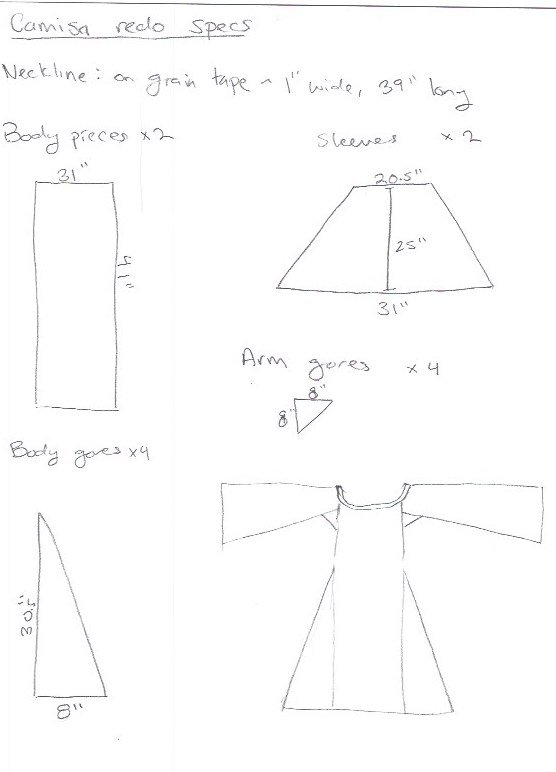Redoing the Camisa
When I first built the camisa for my Spanish garb set, I followed a few tutorials that were more focused on Italian construction. This got me close to what I wanted to accomplish for the fullness of the camisa, but with one major issue: the fit around the chest and neckline was too big. There ended up being a lot of extra fabric around the chest, which made the saya fit a little awkwardly. The neckline was a little too large as well and got consistently pulled out of place underneath the saya sleeves.
Before this piece was ready to be submitted for Tempore Atlantia, those issues had to get fixed. Based on drawings and information available to me, I decided to cut down the front and back panels to add gores to the body of the piece. I eliminated the sleeve gores in the process as well.
The last major change I tried to make was to the neckline. It's still a gathered neckline, but instead of bias binding around it, I tried adding a wider, flat cut facing. This was in theory, to help with my eventual embroidery on the neckline as seen in certain portraits. That extra space of the facing could have helped stabilize the shape and size of the neckline and give me a canvas to work on when I start doing blackwork on these camisas. This was the wrong decision. Nothing on the facing lined up properly with the gathering, any of the 5 different times I tried it. I was forced to abandon the facing idea and go with a wider, on the grain fabric tape.
The changes I made did not go great. I over-compensated for the issues I had and made the garment too small in the chest. I ultimately had to pull out the seams I had sewn up the sides and add some extra fabric from the sleeves down through the start of the body gores. This process did however show me I was wrong about the sleeve gores- those are necessary and are included as a feature in my final design for this piece. The resultant garment had more space in the chest than was originally planned for this redo, but still substantially less than the original prototype.
The conundrum with the facing and fabric tape, however, ultimately revealed the true extent of how critically bad that size correction was. Once the neckline was gathered into the fabric tape, even with the added width, it was way too small under the arms. It was to the extent that the garment was unwearable. I came to the conclusion that it had been a critical failure and I needed to scrap it and start again. During deconstruction, the very light camisa fabric revealed that it had been too heavily manipulated in most places to reuse, and I ultimately decided to start from scratch.
Upon some basic calculations, I suspect that this third edition will require closer to 5 yards of linen. Thankfully, I already had 3 yards of my go-to 3.5 oz linen, so that's a decent place to start. This draft will include 31" wide body panels, similar width sleeves, arm gores, and side gores to bring the bottom width of the camisa to 45" total with seam allowance. I am also going to attempt making the sleeves in a trapezoidal shape, to mitigate some of the fabric building up around the chest area.
All in all, this has been an interesting project. I think my instinct to go the Italian route instead of the English route has been the correct one. That said, the experimental nature of this piece has also been a challenge. It makes me wish I had better sources to go off of, but thankful for the knowledge I have accumulated that makes it so I still can build something workable, even when I totally muck it up.
